Options
How Many 1849 Major Gold Dollar Varieties Are There?
U.S. Mint Chief Engraver, James Longacre, introduced his Type I gold dollar design in 1849. During that year he made a number of adjustments to the design which had to do with esthetic and metal flow issues when the coins were stuck. The best known of these varieties are the "Open" and "Close" wreaths. This refers to the wreath on the reverse. The "Open Wreath" variety had a circle which only came up to 2 and 10 o'clock, which is shown below. The "Close Wreath" variety has branches that come close to the "1."
"Open Wreath"
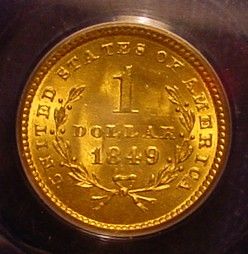
"Close Wreath"

The next design adjustment was with the placement of the bust of Ms. Liberty relative to the stars. The first obverse arrangement, which has been called "the small head," had the point of her crown close to the star on the left. The later variation, which was used for the remainder of the series moved the crown point closer to the star on the right.
The "Small Head" variety
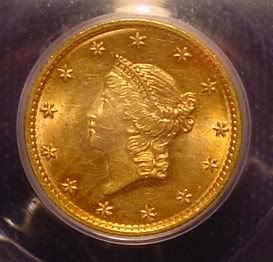
The "Large Head" variety
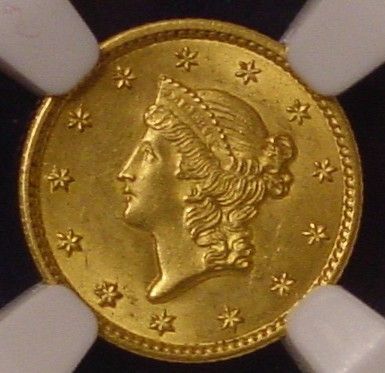
In addition Longacre decided to include his initial "L" on his design, after an initial run of about 10,000 coins, which are known and marked on PCGS slabs as the "No L" pieces. The "L" appears about a quarter way in from the left edge of the bottom of the bust. This is akin to the 1864-L Indian cents which are better known to collectors. Longacre's "L" would appear on the gold dollar for the remainder of the series.
Longacre's "L"
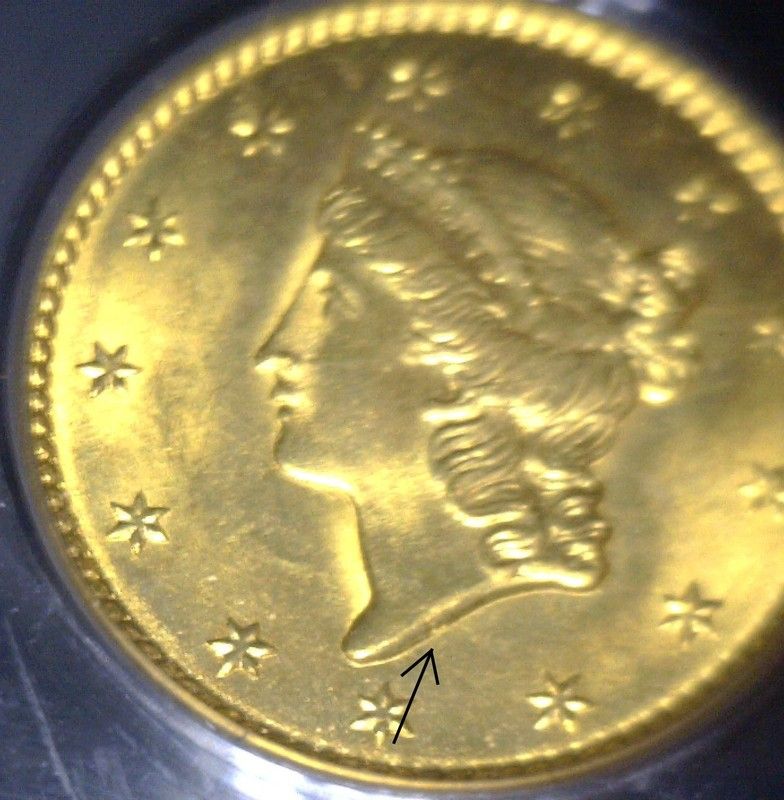
1.. The 1849 No L with the Small Head and Open Wreath.

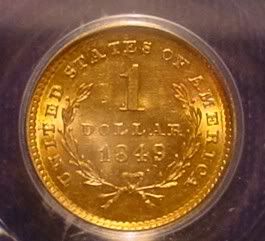
2. The 1849 with the "L" on the Small Head bust and the Open Wreath.
I don't have one of these and have been looking for more than five years. The only example I have seen had been cleaned and was over priced at more than $400. The dealer was not aware of what it was. The item would look like the previous piece except that there is a small "L" at the bottom of the bust.
3. The 1849 with the "L" on the Large Head bust and the Open Wreath.
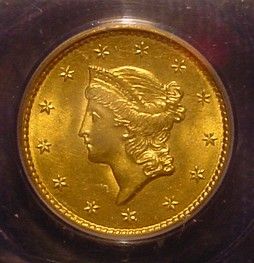

4. The 1849 with the "L" on the Large Head bust and the Close Wreath. This would be the design for the Type I gold dollar for the rest of the series.


Over the past year or so there has been dealer on the show circuit that has been offering a five piece set of 1849 one dollar gold piece die varieties. I have been unable to come to terms on this set because the dealer will not break it up, and I have no use for at least three of the coins that are in it. He claims that there a spot in the PCGS registry for this set, and that this set was the #1 rated set. I can't confirm this.
My question for gold dollar specialist is, are there really five 1849 gold piece varieties, and if there are, what is the fifth one?
Even if you don't know the answer, a discuss of these coins would be interest to me. Go ahead and join the discussion if you like.
"Open Wreath"

"Close Wreath"

The next design adjustment was with the placement of the bust of Ms. Liberty relative to the stars. The first obverse arrangement, which has been called "the small head," had the point of her crown close to the star on the left. The later variation, which was used for the remainder of the series moved the crown point closer to the star on the right.
The "Small Head" variety

The "Large Head" variety

In addition Longacre decided to include his initial "L" on his design, after an initial run of about 10,000 coins, which are known and marked on PCGS slabs as the "No L" pieces. The "L" appears about a quarter way in from the left edge of the bottom of the bust. This is akin to the 1864-L Indian cents which are better known to collectors. Longacre's "L" would appear on the gold dollar for the remainder of the series.
Longacre's "L"

1.. The 1849 No L with the Small Head and Open Wreath.


2. The 1849 with the "L" on the Small Head bust and the Open Wreath.
I don't have one of these and have been looking for more than five years. The only example I have seen had been cleaned and was over priced at more than $400. The dealer was not aware of what it was. The item would look like the previous piece except that there is a small "L" at the bottom of the bust.
3. The 1849 with the "L" on the Large Head bust and the Open Wreath.


4. The 1849 with the "L" on the Large Head bust and the Close Wreath. This would be the design for the Type I gold dollar for the rest of the series.


Over the past year or so there has been dealer on the show circuit that has been offering a five piece set of 1849 one dollar gold piece die varieties. I have been unable to come to terms on this set because the dealer will not break it up, and I have no use for at least three of the coins that are in it. He claims that there a spot in the PCGS registry for this set, and that this set was the #1 rated set. I can't confirm this.
My question for gold dollar specialist is, are there really five 1849 gold piece varieties, and if there are, what is the fifth one?
Even if you don't know the answer, a discuss of these coins would be interest to me. Go ahead and join the discussion if you like.
Retired dealer and avid collector of U.S. type coins, 19th century presidential campaign medalets and selected medals. In recent years I have been working on a set of British coins - at least one coin from each king or queen who issued pieces that are collectible. I am also collecting at least one coin for each Roman emperor from Julius Caesar to ... ?
0
Comments
If the only 'L' open wreath you've seen in five years was overpriced at 400, was it really overpriced ?
<< <i>I don't know the fifth one but these sure are beautiful little coins.
If the only 'L' open wreath you've seen in five years was overpriced at 400, was it really overpriced ? >>
Maybe, maybe not, but it was NGC certified as a low end Unc., and I hate to say it, but the coin was really ugly. More than half of the money spent on the piece would have been "down a rat hole" since the vast majority of collectors don't even know that this coin exists or even care.
I have not quite figured out the difference between Var. 2 & 3. I have seen a complete set of these, all in PCGS 63 or better, on display at one of the national shows in the past year. I have 4 of the 5, but am not sure if I am missing the 2 or the 3.
Breen's Encyclopedia lists 6 major varieties, and notes at least 3 more minor varieties
> 1. The 1849 No L with the Small Head and Open Wreath.
1. Breen 6000 "Coronet point nearer [left] star, no L", 2 minor rev. varieties (Breen actually says the coronet point is midway between stars, but Bill Jones' example looks left to me)
1. Dannreuther Obv. 1
> 2. The 1849 with the "L" on the Small Head bust and the Open Wreath.
2.1 Breen 6001 "Coronet point midway between stars, with L, flat obv. fields", star below bust point far from bust, includes 3 die varieties
2.1 Dannreuther Obv. 3
2.2 Breen 6002 "Coronet point midway between stars, with L, concave obv. fields", star below bust point closer to bust, star at 5K double punched, showing 9 points
2.2 Dannreuther Obv. 2
> 3. The 1849 with the "L" on the Large Head bust and the Open Wreath.
3.1 Breen 6003 "Large head, Coronet point nearer right star, Open Wreath"
3. Dannreuther Obv. 4, Rev. Open Wreath
3.2 Breen 6004 thin serifs and horizontal elements of rev. numerals
> 4. The 1849 with the "L" on the Large Head bust and the Close Wreath.
4.1 Breen 6005 "Large head, Coronet point nearer right star, Closed Wreath"
4. Dannreuther Obv. 4, Rev. Closed Wreath
4.2 Breen 6006 thin serifs and horizontal elements of rev. numerals
It seems the distance between the star and bust point is the key for distinguishing 2.1 and 2.2 (to yield the 5th major variety).
There are good photos in Breen's Encyclopedia of this distance.
Here are 2 images from PCGS Coin Facts showing the star distances for 2.1 and 2.2:
distant star (2.1, Breen 6001)
closer star (2.2, Breen 6002), next 2 stars to right double-punched
If they were, why are some stars double punched? If they were not, then the slight difference in the star position between 2.1 and 2.2 might be just random die engraving, as on Capped Bust halves, and not a major variety.
As to the concave die, that may have been a deliberate experiment at trying a different basining wheel to see if it would make the coins strike up better without being a "design difference."
The concave obv. fields are what Breen and Dannreuther emphasize as the difference between 2.1 and 2.2.
However, concave vs. flat may be difficult to distinguish on a standard photograph.
Also, Breen describes 2.2 as having the star *very* close to the bust - almost touching.
I was not able to find an online image of this so far, though.
I can barely make out an L at the truncation of the neck if I tilt the coin just right, in just the right light, using my 20X loupe... I think
Liberty: Parent of Science & Industry
John Dannreuther indicated to me that he felt the D-2 and D-3 are the two scarcest varieties.